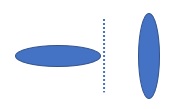
There are fields of study in both symmetrical and asymmetrical areas, but this page is about the balance between the two. As a system concept, I think this perspective is also interesting.
There are two points on this page.
The following law of vertical and horizontal winding is an example of such a balance between symmetry and asymmetry. I don't know of any other examples, but I feel that it can be used as an analogy.
It seems that there are three types of asymmetry in the symmetry.
When viewed from the outside, the human body is symmetrically arranged on both the left and right sides, like the hands, legs, eyes, and ears. On the other hand, the internal organs and brain inside the body are asymmetrical.
The hand, when viewed from the outside, is symmetrical, The dominant hand is easier to move as you want, and the height of function is asymmetrical on the left and right.
From the outside, there is another kind of symmetrical and asymmetrical function, and the asymmetry of function is when there is a complementary relationship. "Complementary" means "complementing each other for what we don't have."
This is the law of vertical winding and horizontal winding below.
There are three types of asymmetry in the above. The way the left and right asymmetry manifests itself is asymmetrical. That is, there is also an asymmetry in the incidence of left and right.
If the inner arrangement is asymmetrical, For example, the left and right sides of the internal organs are the same for most people, but in rare cases, there are people who have the opposite.
If the height of the function is asymmetrical, For example, there are more right-handed people.
It is a law that the human body is clearly divided into those that are easy to move vertically and those that are easy to move horizontally. It doesn't seem to be in print very often, but you can look it up online. In the case of the author, I had the opportunity to learn that it is applied as a method of rehabilitation and manipulative treatment for developmental disorders.
As an application, there is a way to throw the ball, and "if the thrower's arm is vertical, an overthrow is good, and a horizontal person is good at a side throw." It seems that there is such a thing.
In the case of the law of vertical and horizontal winding, not only is the left and right sides asymmetrical, but it is also characterized by the fact that the roles of left and right, which are good at vertical and good at horizontal, are separated, and that the vertical and horizontal are used as one function by two.

In the case of the law of vertical and horizontal winding, the difference between the left and right sides is a pair of "vertical and horizontal".
If you move vertically and horizontally at the same time, you can create a spiral-like movement. In the case of complementarity, working together makes it possible to do things that cannot be done by one or the other.
It can also be said to be a type of interaction.
In humans, the length of the limbs is basically the same on the left and right.
However, if you have a habit of using your body, the length of the left and right sides will shift rather easily, although it is about a millimeter. Even if you are only moving symmetrically, the length of the left and right sides will shift. In other words, if you use something that has an asymmetrical function, the outer symmetry will decrease.
In the rehabilitative manipulative body, you will be taught how to maintain the symmetry of the outside. When the outer symmetry is high, blood flow is the best and it is easy to move the body.
The internal organs and brain are not symmetrical, and if there is superiority or inferiority to one of them, such as handedness and dominant foot, it seems that asymmetrical body shape is more natural, but it seems that this is not the case. In addition, it seems that it is better to think of the muscles as "inside", and it is OK that the appearance of the muscles is asymmetrical, and if you train consciously and look the same, it will be difficult to move the body.
The above is an example of the human body as a story of something that is symmetrical on the outside. Something that is symmetrical on the outside, like the human body, is a type of mirror-image symmetry.

It is called an "enantiomer", but in the molecular world, apart from yourself, there may be molecules in a mirror-symmetric relationship.
When making molecules, the probability of forming an enantiomer may seem to be the same, but sometimes only one of them can be formed. There is an asymmetry in the incidence.
The functions of enantiomers may seem to be the same, but they seem to be completely different.
Notion: This page is mainly about things that are symmetrical in one thing. For things that are separate as objects, such as enantiomers, I have included them on this page as objects with similar properties.
NEXT 

 Mathematical Models for System
Mathematical Models for System
